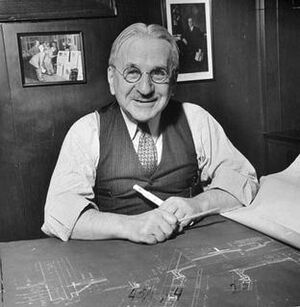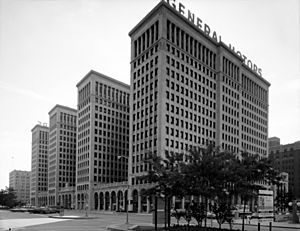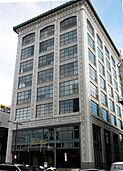Albert Kahn (architect) facts for kids
Quick facts for kids
Albert Kahn
|
|
|---|---|
 |
|
| Born | March 21, 1869 Rhaunen, Kingdom of Prussia (now Germany)
|
| Died | December 8, 1942 (aged 73) Detroit, Michigan, US
|
| Nationality | American |
| Occupation | architect |
| Relatives | Julius Kahn, brother Albert E. Kahn, nephew |
Albert Kahn (born March 21, 1869 – died December 8, 1942) was an American architect who became famous for designing huge factories and industrial buildings. He created places like the Ford River Rouge Complex, which was a massive car factory. He also designed tall buildings and fancy homes in Detroit.
Kahn led a big team of architects. In 1937, his company designed nearly one-fifth of all the industrial factories in the United States! He even helped the Soviet Union (now Russia and other countries) build hundreds of factories. His team trained over 4,000 architects and engineers there. After he passed away, Kahn was given the Frank P. Brown Medal for his amazing work.
| Top - 0-9 A B C D E F G H I J K L M N O P Q R S T U V W X Y Z |
Albert Kahn's Life Story
Albert Kahn was born on March 21, 1869, in a Jewish family in a place called Rhaunen, which was part of Prussia (now Germany). When he was 12, in 1881, his family moved to Detroit, Michigan, in the United States. His father was a rabbi, and his mother was good at art and music. Albert had four brothers, including Julius, who became an inventor and worked with him.
Albert quickly learned English and went to school in Detroit. In 1883, he got a job at an architecture company called Mason and Rice. This is where he started learning about architecture, mostly designing houses and banks. In 1891, when he was 22, he won a special scholarship to study architecture in Europe. He traveled through Germany, France, Italy, and Belgium. After leaving Mason & Rice in 1895, Kahn started his own company with partners. He married Ernestine Krolik in 1896, and they had four children.
In 1902, Kahn teamed up with his brother Julius, who was an engineer. Julius invented a new way to make concrete stronger by adding steel, which he called the "Kahn System." This made it possible to build much larger factory spaces without needing as many support columns. It was also cheaper and safer from fires than older building methods. By 1905, many buildings in the U.S. were using the Kahn System, including the first concrete car factory for Cadillac. Albert Kahn became very well-known for his skill in building these modern concrete factories.
Kahn also designed many other types of buildings. He created homes in Detroit's Indian Village, the Cranbrook House, and the Edsel and Eleanor Ford House. He also designed the Fisher Building in Detroit, which is a beautiful 28-story landmark. In 1929, it was even called the "most beautiful commercial building" of the year. From 1917 to 1929, his firm designed the main offices for Detroit's three biggest newspapers and the General Motors building. When it was finished in 1922, the GM building was the second-largest office building in the world!
Building for Car Companies

Henry Ford, the car maker, was very interested in Albert Kahn's building designs. Ford hired Kahn to design the Highland Park Ford Plant in 1909. This factory was where Ford developed the moving assembly line to build the Ford Model T car very quickly. In 1917, Kahn designed the massive Ford River Rouge Complex in Dearborn, Michigan. This factory complex became the largest manufacturing center in the United States, and later the largest industrial factory in the world, with 120,000 workers!
Kahn's firm was also important during World War I and World War II. They designed many army airfields and naval bases. During World War II, Kahn and his team designed important factories for making airplanes and tanks. His office, with 600 people, helped make Detroit a key part of America's "Arsenal of Democracy" by designing places like the Detroit Arsenal Tank Plant and the Willow Run Bomber Plant. At Willow Run, the Ford Motor Company built thousands of Consolidated B-24 Liberator bombers.
In 1937, Albert Kahn Associates designed 19% of all new industrial factories in the U.S. Kahn worked on over 1,000 projects for Henry Ford alone, and hundreds more for other car companies. He designed car showrooms for Ford in big cities like New York, Washington, D.C., and Boston.
Today, about 60 buildings designed by Kahn are listed on the National Register of Historic Places, which means they are important historical sites. Five of these are even called National Historic Landmarks, like the Fisher Building and the Ford River Rouge complex. Sadly, some of Kahn's buildings have been torn down over time, as cities change and old factories are no longer used.
Fifteen of Kahn's buildings are recognized with official historical markers in Michigan, including:
- The Dearborn Inn
- Detroit Arsenal Plant
- Edsel and Eleanor Ford House
- Fisher Building
- Highland Park Ford Plant
- Packard Automotive Plant
- Willow Run
Work in the Soviet Union
On May 8, 1929, Albert Kahn's company signed a special agreement with the Soviet government. They were hired to help design the Volgograd tractor factory, which was the first tractor plant in the Soviet Union. Then, in January 1930, Kahn's firm became the main consulting architects for all industrial construction in the Soviet Union!
During the Great Depression, when jobs were hard to find in the U.S., Kahn's firm set up an office in Moscow. His brother Moritz and 25 other staff members went to Moscow to train Soviet architects and engineers. They trained more than 4,000 people and designed 521 factories and plants for the Soviet Union's first "five-year plan" to build up its industries.
Famous Buildings by Albert Kahn
Albert Kahn is often called the "architect of Detroit" because he designed almost 900 buildings in the city. Here are some of the many buildings he designed (most are in Detroit, unless noted):
- Hiram Walker offices, 1892, Windsor, Ontario
- Packard Automotive Plant, 1903 (his first concrete factory for Packard)
- Palms Apartments, 1903
- Temple Beth-El, 1903 (his family's synagogue)
- Belle Isle Aquarium and Conservatory, 1904
- Albert Kahn House, 1906 (his own home)
- Willistead Manor, 1906, Windsor, Ontario
- Battle Creek Post Office, 1907, Battle Creek, Michigan
- Cranbrook House, 1907, Bloomfield Hills, Michigan
- Highland Park Ford Plant, 1908, Highland Park, Michigan
- Packard Motor Corporation Building, 1910–11, Philadelphia
- National Theatre, 1911
- Kales Building, 1914
- Detroit Athletic Club, 1915
- Garden Court Apartments, 1915
- Vinton Building, 1916
- Russell Industrial Center, 1916
- The Detroit News Building, 1917
- Ford River Rouge Complex, 1917–28, Dearborn, Michigan
- General Motors Building, 1919 (once the world's second-largest office building)
- First National Building, 1922
- Park Avenue Building, 1922
- The Flint Journal Building, 1924, Flint, Michigan
- Ford Motor Company Lamp Factory, 1921–25, Flat Rock, Michigan
- Detroit Free Press Building, 1925
- Edsel & Eleanor Ford House, 1927, Grosse Pointe Shores, Michigan
- Fisher Building, 1927
- Argonaut Building 1928 (a General Motors laboratory)
- Griswold Building, 1929
- Ford Engineering Laboratory and Powerhouse, 1930, Dearborn Michigan
- New Center Building, 1930
- The Dearborn Inn, 1931, Dearborn, Michigan (the world's first airport hotel)
- Detroit Arsenal Tank Plant, 1941, Warren, Michigan
- Willow Run Bomber Plant, 1941, Ypsilanti, Michigan
Buildings at the University of Michigan
Albert Kahn also designed many classic buildings at the University of Michigan in Ann Arbor. He later said that the William L. Clements Library was the building he most wanted to be remembered for.
- Engineering Building (now West Hall), 1904
- Hill Auditorium, 1913
- Natural Science Building (now School of Kinesiology Building), 1915
- General Library (now Harlan Hatcher Graduate Library), 1920
- William L. Clements Library, 1923
- Angell Hall, 1924
- Physical Science Building (now Randall Laboratory), 1924
- Alexander G. Ruthven Museums Building, 1928
- Burton Memorial Tower, 1936
Albert Kahn's Legacy
Albert Kahn passed away in Detroit on December 8, 1942. His personal papers and many construction photos are kept at the University of Michigan's Bentley Historical Library.
In 1970, an exhibition of his work was held at the Detroit Institute of Arts. It celebrated 75 years since his architectural firm was founded. Many important business leaders who worked in buildings Kahn designed attended the event.
People often called Albert Kahn the "father of industrial architecture." Reader's Digest magazine even called him the "Architect of the Colossal" because of his huge projects. The Franklin Institute recognized him as a pioneer in architecture and gave him a gold medal. The American Institute of Architects also gave him two gold medals during his lifetime. It's estimated that Kahn designed buildings worth billions of dollars before he died.
A book called The Legacy of Albert Kahn talks about his work. It mentions that Kahn never patented his discoveries. Instead, he shared his ideas freely with other architects and engineers, especially during World War I and II, to help with construction efforts.
Historian John Gallagher notes that Kahn designed about 1,900 buildings, including the Fisher Building, the General Motors headquarters, and the Ford River Rouge Complex. While some of his old factories were torn down as they became outdated, many of his other buildings have been updated and are still used today for new purposes.
Images for kids
-
Belle Isle Conservatory (1904) in Belle Isle, Detroit
-
Temple Beth-El (1903) in Brush Park, Detroit
-
First Congregational Church addition (1921) in Midtown Detroit
-
Willistead Manor (1906) in Windsor, Ontario
-
Battle Creek Post Office (1907) in Battle Creek, Michigan
-
Detroit Athletic Club (1915) in Downtown Detroit
-
Fisher Building (1927) in New Center, Detroit
-
Vinton Building (1916) in Downtown Detroit
-
Kales Building (1914) in Downtown Detroit
-
First National Building (1922) in Downtown Detroit
-
New Center Building (1930) in New Center, Detroit
-
Detroit Free Press Building (1925) in Downtown Detroit
-
Argonaut Building (1928) in New Center, Detroit
-
Griswold Building (1929) in Downtown Detroit
-
Ford River Rouge Complex (1917–28) in Dearborn, Michigan
See Also
- Kahn System, the industrial construction technique developed by Julius Kahn
- Architecture of metropolitan Detroit
- Joseph Nathaniel French





















